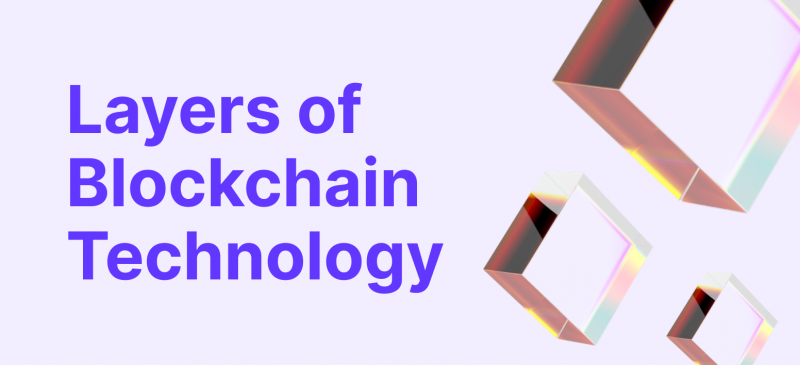Blockchain technology is radically changing the way we conduct business and interact with each other. It is a powerful tool for securely storing, sharing, and processing data. To understand how blockchain works, it’s important to look at its various layers. Each layer of a blockchain’s architecture serves a different purpose and has distinct characteristics that influence how it functions. In this article, we’ll explore the different levels of a blockchain and how they work together to keep data safe and secure.
Key Takeaways
- Blockchain is a distributed ledger of extracted blocks, which contains information about each transaction performed in the network.
- Distributed ledger technology’s scalability implies the ability of the network to operate with higher throughput, which is expressed in the increased flow of transactions per unit of time.
- Blockchain architecture is a hierarchy of interconnected elements, each of which performs a specific function for the network.
What is Blockchain Technology And How Does It Work?
Blockchain is an incorruptible digital ledger used to secure data and transactional records. As new blocks of these records are added, the blockchain grows, with nodes around the world updating their versions of the chain upon each addition. These transactions can be traced all the way back to the block’s inception, due to their time-stamp. Decentralization, lower maintenance costs, transparency (in the case of public blockchains), and immutability without participant approval are just some of the benefits that distributed ledger technology brings. Experts say that the removal of the human element and the use of mathematical calculating algorithms instead also contribute to the effectiveness of this technology.
Blockchain is a modern, multifunctional technology at the intersection of finance and computer science that allows the exchange of information without requiring complete trust. Blockchain enables direct transactions between parties without needing a central data repository or intermediary to guarantee the transaction. This is achieved through a complete and unchanging post-facto record of all transactions, to which all participants in the blockchain platform have full access — the records already entered into the database cannot be changed by either participants or their associations.
The mining process is the key mechanism for writing new operations (in the Proof of Work model) to the blocks in open-source blockchains. This approach is based on organizing competition among network participants, who perform mathematical operations to find the hash of a new block and compete on the time it takes. As miners increase (or decrease) their processing power, the network adjusts the algorithm’s complexity to maintain approximately the same time to generate new blocks in the chain. This approach makes generating a block that meets the confirmation condition challenging because many “random” combinations must be tried until the block is confirmed.
Today, the problem of network adaptability is one of the biggest in the crypto industry. This concern is actively being solved through the use of Layer 1-2 solutions.
What is Blockchain Scalability?
Blockchain is a distributed system focused on two goals: on the one hand, it allows everyone to add new transactions to a shared transaction timeline, and on the other, it ensures that the timeframe of transaction data is protected from changes and tampering. The blockchain system achieves both goals through an immutable, add-only data structure that solves a hash puzzle each time a new block is added. Solving the hash puzzle is time-consuming, so any attempt to change the chronology of transactions would involve too much effort. Unfortunately, such a structure comes at the cost of reduced data processing speed, the consequence of which is the limited scalability of the system.
Scalability is the ability of a network or database to increase its performance under overload conditions. There are vertical (by improving the hardware) and horizontal (by distributing the load evenly over small segments) scaling of the system. The first is realized by increasing the capacity of central nodes, and the second – by software methods. The scalability of the blockchain protocol is generally defined as the ability to process more transactions per second through the usual chains of blocks. Many blockchain systems can be considered scalable these days, but their throughput varies widely. When a system is called scalable, it achieves a higher TPS than existing systems by changing the consensus protocol and/or refining some system parameters.
Several blockchain network scalability schemes exist today, the main ones being Proof-of-Work, Proof-of-Stake, and Byzantine fault tolerance (BFT). While all of these schemes may differ in form and concept, they can have similar performance in terms of throughput. Ideally, all approaches maximize bandwidth utilization for message transfer and provide unobstructed message complexity. The fundamental difference between them is that scalability in distributed systems requires a linear increase in system performance and the number of servers (nodes), which is essentially unattainable for blockchain due to decentralization.
The Blockchain Architecture: Definition and Overview
Each blockchain that exists today in the crypto space is a multi-component system of interconnected elements, the correct operation of each of which ensures the stability of the entire blockchain architecture. Architecture is a set of levels, at each of which certain processes are executed that, in one way or another, affect individual aspects of the network’s performance and determine the possibility of its scaling.
Hardware Layer
The hardware infrastructure layer is the most fundamental layer of a blockchain. It houses the nodes that process and store ledger transactions. Peer-to-peer networks are the basis of blockchain platforms. In this network, nodes interconnect to exchange and share data among various devices. Each node in the network is allowed to randomly track data during transactions.
A distinctive feature of blockchain networks is that, regardless of which group of nodes checks a freshly mined block, information about it is updated for all nodes simultaneously. Consequently, the validation node acts as a server, while the update nodes act as a client in this case. Such a system, where each node can act as both a server and a client, is based on the hardware level, the primary purpose of which is to ensure the shelteredness of the blockchain crypto ledger from unauthorized access by verifying and storing blockchain transactions in a decentralized manner.
To achieve this goal, a distributed database is created that stores all information in a blockchain format that is transparent and chronological. All data or transactions that take place on the blockchain are verified by this layer using different consensus mechanisms.
Data Layer
The data layer is a secure and stable chain that acts as a database to store transaction information. Once a set number of transactions have been verified by the nodes, they are added to a block and linked to the previous block in the chain (except for the genesis block, which is the first block in the chain). Every block contains essential details such as the Merkle tree’s root hash, the previous block’s hash, date, and other relevant data. This ensures the system’s security, integrity, and immutability.
Each blockchain transaction uses a digital signature created using a private key held in the sender’s wallet. Because this key is only available to the sender, anyone cannot access the data. In addition, the digital signature protects the owner’s identity, which is encrypted for security. This stage of the process is called “finality.”
Network Layer
The network layer is the third layer of the blockchain architecture, also called the peer-to-peer layer. It is responsible for managing and maintaining the blockchain’s network infrastructure and is the distribution layer, where block creation, block addition, and communication between nodes occur. Nodes and miners use computing power to solve complex mathematical problems in this layer to consistently transmit transactional data across the peer-to-peer network and validate transactions. In this way, the network layer ensures the legitimacy of transactions.
The peer-to-peer layer of a blockchain structure allows nodes to exchange data about transactions and come to an agreement about their validity. This network layer is responsible for allowing P2P communication between nodes and is sometimes also called the ‘branching’ layer. It contains mechanisms such as those for P2P networks, data transfer, and validation.
Consensus Layer
The consensus layer is crucial to the blockchain. It sets the consensus rule between nodes and is responsible for the blockchain’s critical functionality. Consensus is achieved in a decentralized manner, which means there is no need for a central authority. Multiple nodes control transaction data, and they must all authenticate each other’s transactions and agree on them. If the consensus layer fails, the entire blockchain system fails as well.
The consensus layer ensures that all nodes in the network are able to verify and agree on transaction data, thus guaranteeing that every detail stored within the blockchain is approved by each node. This layer involves algorithms and protocols which enable multiple computers to reach an agreement when creating new blocks or modifying existing records.
Application Layer
At the application layer are the programs that provide the deterministic nature of the blockchain. They make it easy for consumer devices to communicate with the blockchain and are the front end facing the user. The blockchain stack, in turn, acts as the back end. Developers can deploy programs on top of this stack and have the computer execute them.
The application layer of a blockchain network consists of scripts, APIs, user interfaces, frameworks, smart contracts, and dApps. It is divided into two parts: the application layer and the execution layer. The former initiates transactions while the latter carries out the verification process. Finally, the semantic layer executes them.
The Layers of Blockchain Protocols
Blockchain architecture is often presented as a hierarchical level system, where each layer has its own features and functions. No matter which consensus method is used within a blockchain architecture, layers offer a range of solutions for scaling the network. Let’s take a closer look at these layers.
Layer 0
The L0 protocol forms the basis of the L1 blockchain architecture. One approach to addressing the interoperability and adaptability obstacles currently facing blockchain technology is the L0 protocol, the basis for blockchain networks and applications.
Networks created using the same L0 protocol can automatically communicate with each other without the use of special bridges. Blockchains in the ecosystem can build on each other’s functions and use cases by using different transfer protocols between chains or L0s. This often results in faster transaction times and greater efficiency.
In most cases, L0 protocols act as the primary blockchain, supporting transaction data from multiple L1 chains. In addition to network protocols that allow tokens and data to be transferred between distinct crypto ledgers, there are L1 chains built on top of L0 protocols. From one L0 protocol to another, the architecture and connections of these three components can vary greatly.
Layer 1
Layer 1 distributed registries include blockchains that process and terminate transactions inside themselves. This layer performs large, essential tasks that support the fundamentals of the network: programming languages, dispute resolution, consensus method, and constraints.
A popular method of scaling Layer 1 to increase transaction throughput is segmentation. This type of database partitioning method can be used with distributed registries on blockchains. The network and its nodes are divided into multiple segments to distribute the workload and increase transaction throughput. Each segment controls part of the network activity. Therefore, each fragment has its own transactions, nodes, and individual blocks.
Layer 2
Layer 2 solutions are infrastructure solutions in the form of applications and software built on top of underlying blockchains. They can handle large transaction volumes and reduce the lo ad on the underlying network. There are now several options for second-tier solutions: sidechains, state channels, and optimistic and ZK rollups. Layer 2 solutions are designed to circumvent the limitations of scalability, isolation, and low flexibility for developers.
Layer 3
Layer 3, also known as the application layer, is the arena for decentralized network applications and services and their usage protocols. While some blockchains, such as Ethereum or Solana (SOL), support a stable ecosystem of Layer 3 applications, Bitcoin is not suitable for this. Layer 2 solutions from the core Bitcoin network are currently the most popular. Some projects are trying to integrate DApp capabilities into the BTC ecosystem through forks of the original network.
Conclusion
The distributed ledger is a sophisticated system that serves as the basis for various digital products, cryptocurrency applications, and projects. As the blockchain networks of different cryptocurrencies continue to develop and improve scalability, the use of distributed ledger technology will become more widespread. This type of technology opens up many potential applications that could have a major impact on our lives and the way we conduct business.











